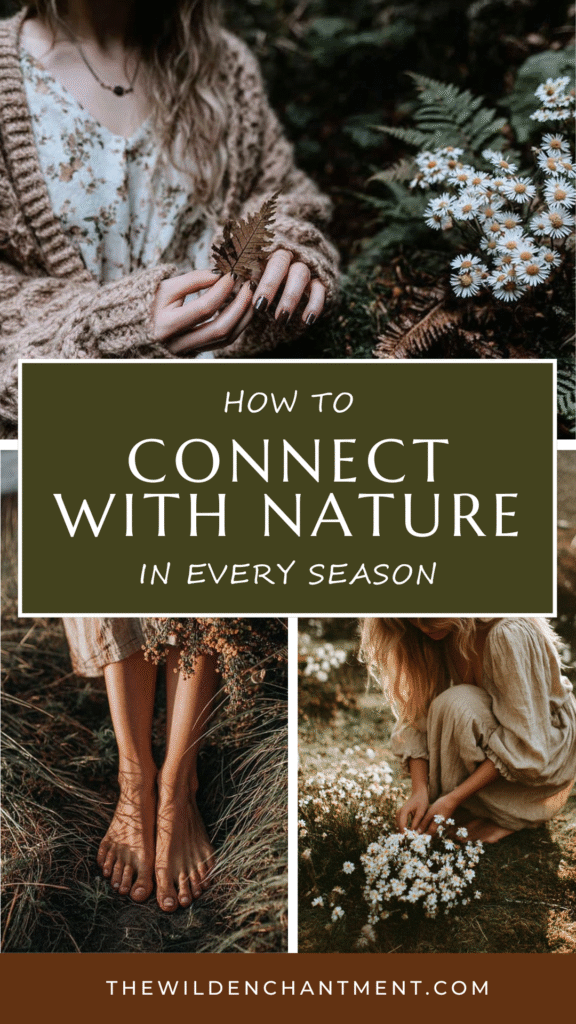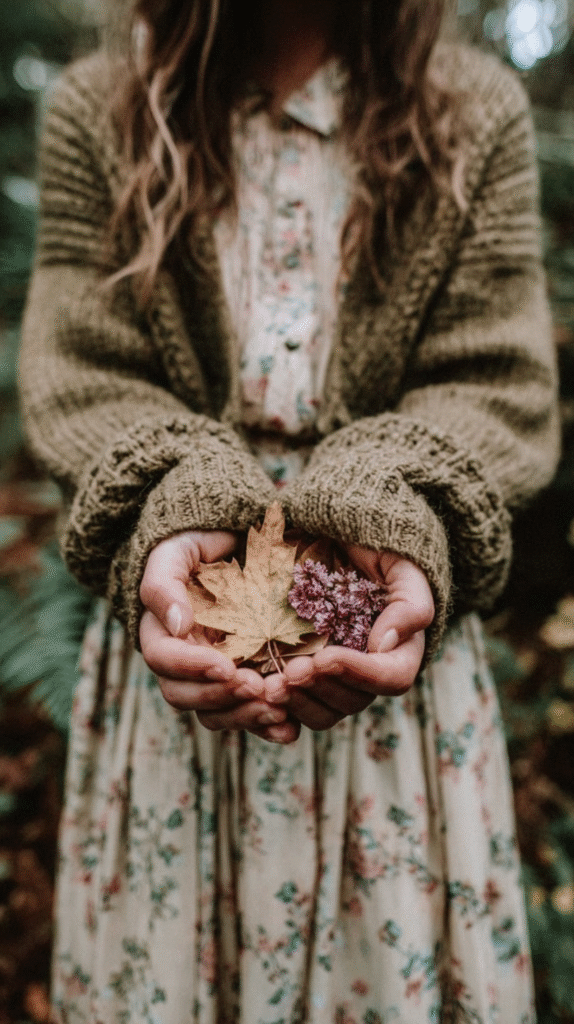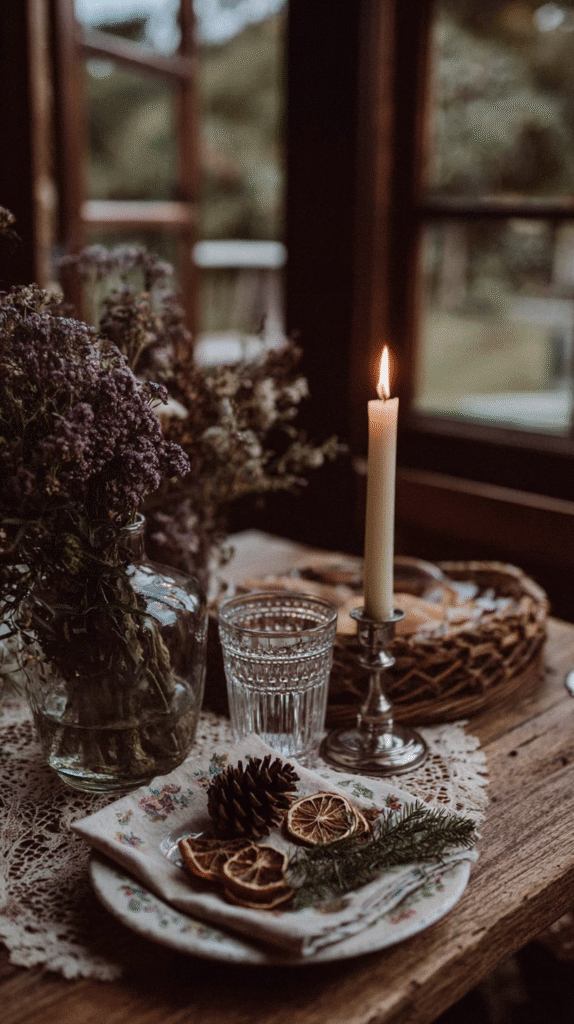This post may contain affiliate links, including those from Amazon Associates. If you make a purchase through these links, I may earn a commission at no additional cost to you. Learn more about our affiliate policy.
Sometimes the longing to feel connected to nature grows strongest when we feel most distant from it.
Life can become a blur of screens, schedules, and noise, and suddenly weeks pass without noticing how the light shifts or what the air smells like.
The Wild Woman inside us, the curious, grounded and instinctive part, starts to ache for something simpler.
You don’t need a cabin in the woods or endless free time to answer that call. Nature is always there, waiting in small moments and subtle changes.
Whether you live in a city apartment or near open fields, each season holds an invitation to reconnect.
These simple, sensory practices will help you align with nature’s rhythm all year long and rediscover the calm and creativity that come from belonging to the earth again.

Why Nature Connection Matters
Spending time with nature isn’t just poetic, it’s profoundly healing. Studies show that even a few minutes among trees or plants can lower stress, improve focus, and lift mood.
But beyond research, nature gives something more personal: perspective.
For women who feel pulled between inspiration and exhaustion, nature offers grounding. It reminds us that cycles are normal. That growth and rest coexist.
That creativity, like the seasons, unfolds in its own timing.
When you align your rhythm with the natural world, life begins to feel steadier and more sacred.
Connecting with nature doesn’t have to mean escaping your life. It simply means noticing the world as it is right now, and participating in it.
Spring: The Awakening Earth

Spring carries the energy of renewal. The light grows longer, birds return, and even the soil seems to breathe again. If you often feel inspired but unsure where to start, this season whispers: begin.
What to notice: the scent of thawing earth, new buds, rain on pavement, a single bright bloom in a sidewalk crack.
Simple practice: take a ten-minute walk once a week in the same place like a nearby park, a tree-lined street, or your backyard. Notice what changes. Pick one sign of new life and pause to really look at it.
Creative variation: press a flower or bud between pages of a notebook. Write a word beside it that describes how you want to grow this season with clarity, courage and ease.
Spring’s lesson is gentle action. You don’t need to plan or perfect, only to begin. Let nature’s momentum carry you forward.
Summer: The Wild Growing Light

Summer is the season of fullness. The days stretch endlessly, the air hums with bees and scent, and color reaches its peak.
Yet even in summer’s warmth, many women find themselves overwhelmed, busy, overstimulated, always chasing more.
What to notice: golden light on late evenings, the scent of warm herbs, the hum of life in every direction.
Simple practice: set aside one evening a week to be outside without an agenda. Sit on a balcony, porch, or patch of grass. Sip something cold and simply watch the light change. Let yourself feel the air on your skin.
Creative variation: gather a few fallen blooms or herbs and place them in a small jar on your windowsill. This becomes your “summer altar,” a reminder to savor rather than strive. Learn more about keeping a seasonal altar here.
Summer’s lesson is presence. It teaches that joy doesn’t need to be earned, it’s already around you, alive in the moment.
Autumn: The Turning Wheel

Autumn invites release. The air turns crisp, the light softens, and trees let go without fear. It’s a season of beauty and surrender, perfect for women who carry too much on their shoulders.
What to notice: color changes in leaves, earlier sunsets, the scent of woodsmoke, the sound of wind through dry grass.
Simple practice: on a walk, gather three leaves of different colors. As you press each one between your palms, name something you’re ready to let go of. It could be self-doubt, comparison, or simply rushing through your days.
Creative variation: make a simple nature garland using twine and your collected leaves, acorns, or seed pods. Hang it near your doorway as a reminder that release is part of renewal. Find more nature craft projects to honor the season with foraged finds here.
Autumn’s lesson is acceptance. Change doesn’t mean loss, it’s a clearing that makes space for what’s next.
Winter: The Long Slow Turn

Winter holds the magic of stillness. The trees are bare, the air cold and sharp, and everything slows to rest. We can often feel disconnected during darker months, yet winter can be a teacher of deep calm.
What to notice: the texture of frost on windows, candlelight against darkness, the muffled sound of snow or rain.
Simple practice: spend five minutes outside at dusk, even if it’s just on your doorstep. Breathe in the cold air and exhale slowly. Notice how the world settles when you do.
Creative variation: create a small winter vignette on a shelf or table using pinecones, dried citrus, and evergreen sprigs. Light a candle nearby in the evenings. This small ritual brings warmth and the reminder that life continues quietly even in rest.
Winter’s lesson is stillness. Growth is happening beneath the surface. Trust it, and let yourself rest too.
Overcoming Common Barriers
“I don’t live near nature.” Even city streets hold life like trees, birds, sunlight on glass. Nature exists in every crack and corner. A single plant on your desk or a window view of the sky can be enough to reconnect. Find more ways to ground when you live in a city here.
“I’m too busy.” Start with micro-moments. Open a window first thing in the morning and take three deep breaths. Look at the horizon before checking your phone. You don’t need an hour, only awareness. Find more ways to create a natural morning routine here.
“It’s cold or rainy.” Every season has beauty. Bundle up and step outside for a few minutes, or bring nature indoors with branches, herbs, or natural textures. Let the weather remind you that life is cyclical, not controllable.
“I’m not outdoorsy.” You don’t have to be. Nature connection is not about hiking or camping. It’s about noticing, touching, and being present. A small garden pot, a bird feeder, or a cup of tea on the porch is enough.
Give yourself permission to connect imperfectly. Nature doesn’t demand effort, only attention.
Bringing Nature Into Your Home and Creative Life
Your home can become an extension of the natural world. Decorate seasonally with simple, meaningful touches. In spring, display pressed flowers. In summer, gather small bowls of shells or stones. In autumn, bring in dried herbs or seed pods. In winter, use pinecones or a single evergreen branch.
Let your creative projects follow these same rhythms. Paint, craft, or write with seasonal colors and textures. When you make crafts with natural materials, you participate in nature rather than just observing it. The handmade becomes sacred again.
Closing Reflection
Reconnecting with nature is really about remembering that you belong. You are not separate from the cycles around you; you are made of the same elements that turn, rest, bloom, and fall away.
You don’t need perfection or plans to begin. Just step outside, breathe, and look up. Notice what’s alive today—sunlight on leaves, clouds drifting, a single bird crossing the sky. That moment of awareness is enough.
As the seasons turn, you’ll start to feel the shift within yourself too. More calm. More clarity. More wonder. Nature connection is not something you add to your life; it is life, patiently waiting for you to return.



